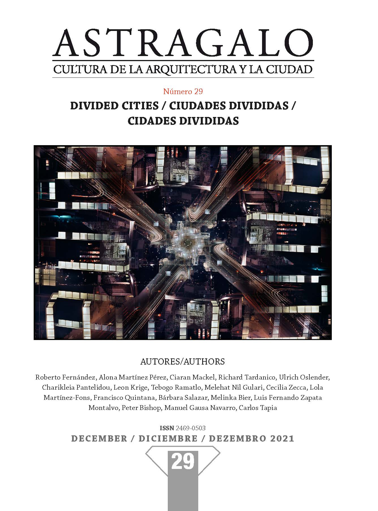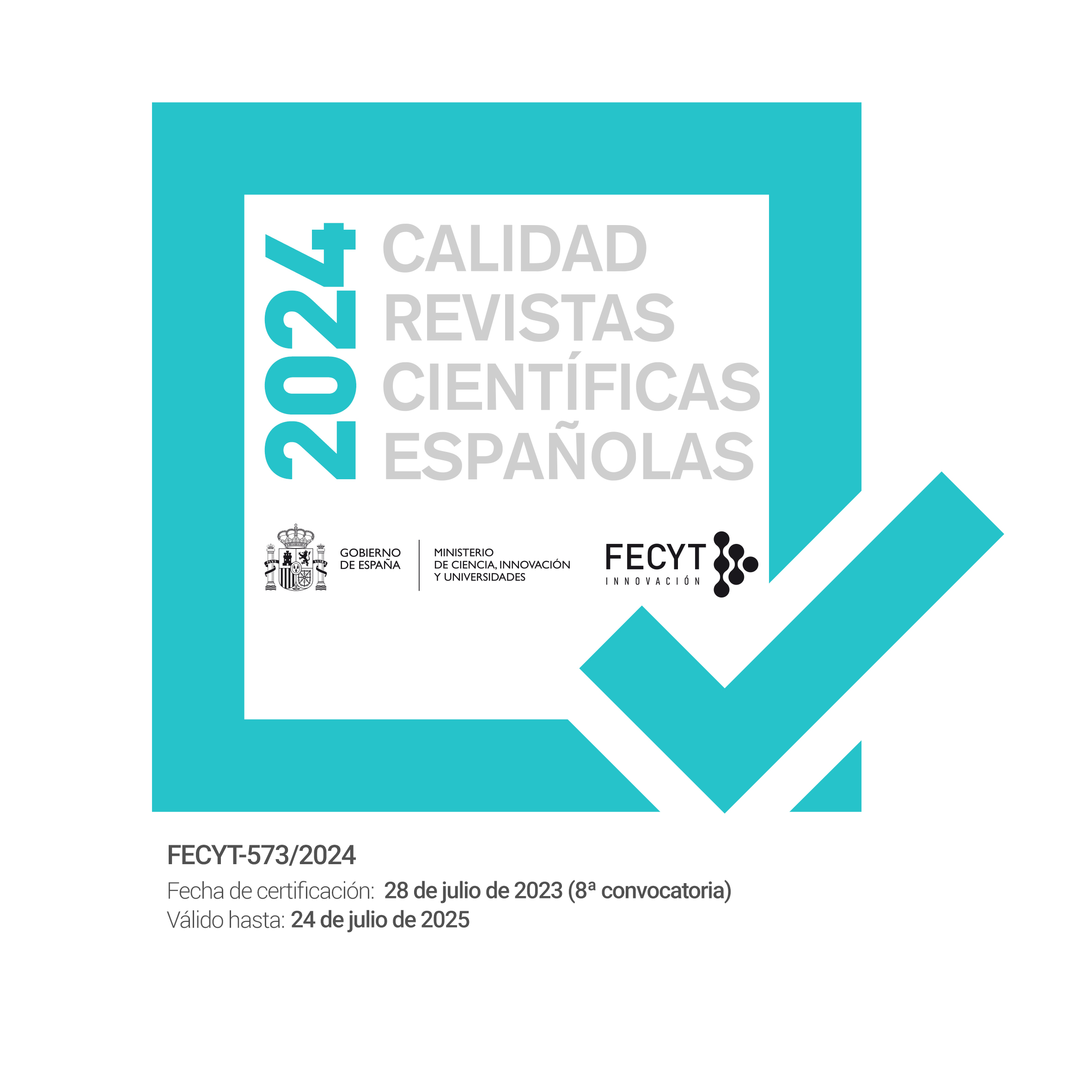Lugares de exclusividad y exclusión
De la casa al barrio y de la ciudad al islote
DOI:
https://doi.org/10.12795/astragalo.2021.i29.06Palabras clave:
vivienda, interioridad, límites, gated communities, diversidadResumen
En las últimas décadas nos enfrentamos a una transformación urbana basada en la exclusividad. Los barrios cerrados se encuentran en todo el mundo en un intento de las clases medias de protegerse frente al otro mediante la práctica de métodos de injusticia espacial. Sin embargo, lo que distingue el caso de los barrios cerrados de otros métodos de exclusión urbana es el hecho de que la exclusión del "otro" es coherente con la restricción de lo "normal" mientras que al mismo tiempo los conceptos de interior y exterior se reinterpretan y redefinen, en referencia a la espacialidad. En este contexto, la ciudad contemporánea adquiere nuevas formas y significados, alejándose de la organización espacial contemporánea y las correlaciones habituales de formaciones espaciales y sociales. Surgen las preguntas: ¿Cuáles son las cualidades espaciales y sociales de los barrios cerrados? y ¿cómo el fenómeno de los barrios cerrados transforma el espacio urbano moderno. A través de la elaboración teórica del tema y el análisis del contenido de una novela de literatura contemporánea intentamos conocer las transformaciones e inversiones que se producen en el paisaje urbano en la realidad contemporánea de la exclusión espacio-social.
Descargas
Citas
Boyle, Thomas Coraghessan. 1996. The Tortilla Curtain. Toronto: Penguin.
Bakhtin, Mikhail. 1984 [1968]. Rabelais and his World, trans. by H. Iswolsky. Bloomington: Indiana University Press.
Bauman, Zygmunt. 1997. Postmodernity and its discontents. New York: New York University Press.
Blakely, Edward y Snyder, Mary Gail. 1997. “Divided We Fall. Gated Communities in the United States”. Architecture of Fear, editado por Nan Ellin and Edward Blakely. New York, NY: Princeton Architectural Press: 85-99.
Butler, Judith. 1997. The Psychic Life of Power: Theories in Subjection. Redwood City CA: Stanford University Press.
Debord, Guy. 2002 [1970]. Society of the Spectacle. St Petersburg FL: Black and Red.
Dripps, Robert Dunning. 1997. The first house: Myth, paradigm, and the task of architecture. London and Cambridge, MA: MIT Press.
Foucault, Michel. 1982. “The Subject and Power”. Critical Inquiry, 8, 4: 777-795.
Foucault, Michel. 1991. “Governmentality.” The Foucault Effect: Studies in Governmentality, editado por Graham Burchell, Colin Gordon y Peter Miller. Chicago: University of Chicago Press: 87-104.
Grant, Jill y Mittelsteadt, Lindsey. 2004. “Types of gated communities”. Environment and Planning B: Planning and Design. 31, 6: 913-30.
Harvey, David. 1992. "Social justice, Postmodernism and the City." International Journal of Urban and Regional Research, 16, 4: 588–601.
Kondylis, Panagiotis. 1991. Der Niedergang der burgerlichen Denk- und Lebensform. Die liberale Moderne und die massendemokratische Postmoderne. Weinheim: Acta Humaniora.
Lefas, Pavlos. 2009. Dwelling and Architecture: From Heidegger to Koolhaas. Berlin: JOVIS.
Le Goix, Ronald. 2006. “Gated Communities as Predators of Public Resources: The Outcomes of Fading Boundaries between Private Management and Public Authorities in Southern California”. Private Cities. Global and Local Perspectives, editado por Georg Glasze, Chris Webster and Klaus Frantz. London; New York: Routledge: 76-91.
Low, Setha. 2004. Behind the Gates: Life, Security, and the Pursuit of Happiness in Fortress America. London, Routledge.
Marcuse, Peter. 1995. “Not Chaos, but Walls: Postmodernism and the Partitioned City”. Postmodern Cities and Spaces, editado por Sofia Watson and Kathie Gibson. Oxford: Blackwell: 243-53.
McKenzie, Evan. 2006. “The Dynamics of Privatopia: Private Residential Governance in the USA”. Private Cities. Global and Local Perspectives, editado por Georg Glasze, Chris Webster and Klaus Frantz. London; New York: Routledge: 9-30.
Pantelidou, Charikleia. 2019. Gated Communities and Spatial-Social Exclusion: Form and Meaning Transformations in the Contemporary Urban Space. Athens: Nissos (in Greek).
Pantelidou, Charikleia. 2020. “The Spatial Ethos of the Carnivalesque: Urban Space as ‘the-private-within-the public“. The City and Complexity: Life, Design and Commerce in the Built Environment, Proceedings of the AMPS -Architecture, Media, Politics and Society- 2020 International Conference. University of London. Vol. 2: 180-187.
Paraskevopoulos, Nikos. 2008. “The extension of criminal law: real and symbolic dimensions”. Honorary Volume for Anna Benaki-Psarouda: Criminal Sciences, Theory and Praxis. Athens: Sakkoula: 485-496 (in Greek).
Petropoulou Chryssanthi. 2020. “Ciudades invisibles y cambio de habitus: narrativas cartográficas, poéticas y rebeldes. Ejemplos de Ciudad Bolívar (Bogotá) y Comuna 13 – San Javier (Medellín)”. Narrativas, Geografias, Cartografias - para viver, é preciso espaço e tempo, editado por Nelson Rego y Salete Kozel, en colaboración con Ana Francisca de Azevedo. Universidade do Minho, UFPR, UFRGS. Porto Alegre: Editora Compasso Lugar Cultura e Editora IGEO, Vol. 2: 669-723.
Rifkin, Jeremy. 2001. The Age of Access. New York: TarcherPerigee.
Sassen, Saskia. 2010. “Foreword: Urban Gating - One Instance of a Larger Development?” Gated Communities: Social Sustainability in Contemporary and Historical Gated Developments, editado por Samer Bagaeen and Ola Uduku. London: Routledge.
Simon Jonathan, Temple Nicolas y Tobe Renée. 2013. Architecture and Justice: Judicial Meanings in the Public Realm. Surrey: Ashgate.
Tsoukala, Kyriaki. 2010. “Introduction: Postmodern aspects”. Postmodern aspects, editado por Kyriaki Tsoukala, Maria Daniil and Charikleia Pantelidou. Thessaloniki Epikendro: 15-50 (in Greek).
Webster, Chris. 2002. “Property Rights and THE Public Realm: Gates, Green Belts, and Gemeinschaft”. Environment and Planning B: Planning and Design, 29: 397-412.
Wilson-Doenges, Georjeanna. 2000. “An exploration of sense of community and fear of crime in gated communities”. Environment and Behavior 32, 5: 597-611.
Žižek, Slavoi. 1989. The Sublime Object of Ideology. Brooklyn, NY: Verso.
Žižek, Slavoi. 2001. Did Somebody Say Totalitarianism? Brooklyn, NY: Verso.
Descargas
Publicado
Versiones
- 2022-02-07 (4)
- 2022-02-04 (3)
- 2022-02-04 (2)
- 2022-02-04 (1)
Cómo citar
Número
Sección
Licencia
Derechos de autor 2021 CHARIKLEIA PANTELIDOU

Esta obra está bajo una licencia internacional Creative Commons Atribución-NoComercial-CompartirIgual 4.0.












 2024 QUALIS-CAPES: Anthropology / Archaeology A3; Architecture, Urban Planning And Design A3; Urban And Regional Planning / Demography A3
2024 QUALIS-CAPES: Anthropology / Archaeology A3; Architecture, Urban Planning And Design A3; Urban And Regional Planning / Demography A3





